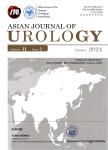The impact of chemotherapy-naïve open radical cystectomy delay and perioperative transfusion on the recurrence-free survival: A perioperative parameters-based nomogram
作者机构:Urology and Nephrology CenterMansoura UniversityEgypt
出 版 物:《Asian Journal of Urology》 (亚洲泌尿外科杂志(英文))
年 卷 期:2024年第11卷第2期
页 面:294-303页
核心收录:
学科分类:1002[医学-临床医学] 100214[医学-肿瘤学] 10[医学]
主 题:Radicalcystectomy Blood transfusion Time to radical cystectomy Survival Nomogram
摘 要:Objective: To develop and internally validate a nomogram to predict recurrence-free survival (RFS) including the time to radical cystectomy (RC) and perioperative blood transfusion (PBT) as potential predictors.Methods: Patients who underwent open RC and ileal conduit between January 1996 to December 2016 were split into developing (n=948) and validating (n=237) cohorts. The time to radical cystectomy (TTC) was defined as the interval between the onset of symptoms and RC. The regression coefficients of the independent predictors obtained by Cox regression were used to construct the nomogram. Discrimination, validation, and clinical usefulness in the validation cohort were assessed by the area under the curve, the calibration plot, and decision curve analysis.Results: In the developing dataset, the 1-, 5-, and 10-year RFS were 83.0%, 47.2%, and 44.4%, respectively. On multivariate analysis, independent predictors were TTC (hazards ratio [HR] 1.07, 95% confidence interval [CI] 1.05-1.08, p0.001), PBT (one unit: HR 1.40, 95% CI 1.03-1.90, p=0.03;two or more units: HR 1.72, 95% CI 1.29-2.29, p0.001), bilateral hydronephrosis (HR 1.54, 95% CI 1.21-1.97, p0.001), squamous cell carcinoma (HR 0.60, 95% CI 0.45-0.81, p=0.001), pT3-T4 (HR 1.77, 95% CI 1.41-2.22, p0.001), lymph node status (HR 1.53, 95% CI 1.21-1.95, p0.001), and lymphovascular invasion (HR 1.28, 95% CI 1.01-1.62, p=0.044). The areas under the curve in the validation dataset were 79.3%, 69.6%, and 76.2%, for 1-, 5-, and 10-year RFS, respectively. Calibration plots showed considerable correspondence between predicted and actual survival probabilities. The decision curve analysis revealed a better net benefit of the nomogram.Conclusion: A nomogram with good discrimination, validation, and clinical utility was constructed utilizing TTC and PBT in addition to standard pathological criteria.



